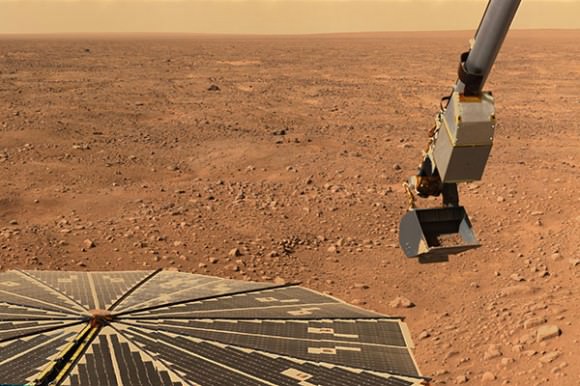It’s time to get ready for Mars, again! NASA has given the approval to begin construction on its 2016 mission, the Interior Exploration Using Seismic Investigations, Geodesy and Heat Transport (InSight) mission.
As the mission implies, the lander (which isn’t moveable) will focus on learning more about the inside of Mars. The idea is to figure out how terrestrial planets are “differentiated” inside between core, mantle and crust. Also, watchers of the Mars program may recognize some parts of the lander, as it will borrow the design from the successful Phoenix mission in 2008.
“We will incorporate many features from our Phoenix spacecraft into InSight, but the differences between the missions require some differences in the InSight spacecraft,” stated Stu Spath, InSight program manager at Lockheed Martin.
“For example, the InSight mission duration is 630 days longer than Phoenix, which means the lander will have to endure a wider range of environmental conditions on the surface.”

NASA mission planners are still determining where InSight will go, but they expect it will be a site near the equator of Mars and that it will last at least two years on the surface.
The Mars lander will include a robotic arm with “surface and burrowing” instruments whose projects are led by the French and German space agencies, which are CNES (National Center of Space Studies) and DLR (German Center for Aerospace), respectively. CNES will contribute a seismic experiment to look at “Marsquakes” and when meteors smack the surface, while DLR’s science experiment will look at interior planetary heat.

The seismometer will sit on the surface, covered up to protect it from the cold and wind, while the heat-flow probe will be hammered in about three to five yards or meters. Investigators also plan an experiment that will communicate with NASA’s Deep Space Network antenna network to see how much the rotation of Mars wobbles, which could hint if the core of the Red Planet is solid or liquid. The mission will also include wind, temperature and pressure sensors, as well as a magnetometer.
“Mars actually offers an advantage over Earth itself for understanding how habitable planetary surfaces can form,” stated Bruce Banerdt, InSight principal investigator at NASA’s Jet Propulsion Laboratory. “Both planets underwent the same early processes. But Mars, being smaller, cooled faster and became less active while Earth kept churning. So Mars better preserves the evidence about the early stages of rocky planets’ development.”
Construction will be led by Lockheed Martin. You can check out more information about InSight at this website. NASA has several missions working at Mars right now, such as the Mars Curiosity rover, the Opportunity rover and the orbiting Mars Reconnaissance Orbiter and Mars Odyssey spacecraft.
Source: Jet Propulsion Laboratory


Sigh…the amount of resources NASA is committing to roving and re-roving and landing and re-landing on Mars- while ignoring other significant areas of solar system exploration- is really disheartening.
NASA just approved- you guessed it- another future rover mission, and then the InSight is going to tunnel down 3-5 meters? Swell. Can’t wait to see all we learn from that, even though it’s less depth than one of the current rovers simply exploring a larger crater rim.
The public has grown content with a steady stream of Mars missions, neither of which really accomplishes much more than the one before it. This allows the real exploration of the solar system to go on covertly. Thanks NASA!
PS Digging down 3-5 meters and hoping to learn something significant about Mars’s interior would be like trying to discern what Earth’s core is like after digging a hole for your kid’s sandbox in the backyard.
Obviously NASA is going to have more sophisticated instrumentation on InSight than your shovel, but I still highly doubt they acquire anything more definitive than a new round of speculation.